The EZView widget queries and downloads EQuIS reports and creates EQuIS Information Agents (EIAs) to automatically send reports. EIAs for grid reports can also be used as a data source for the widget. A primary purpose of the widget is to run the selected report and then export the report output to third party programs, such as Microsoft Excel (.xls) workbooks, Esri ArcGIS shapefiles (.shp), tab delimited (.txt) files, and Google Earth (.kmz) files. The Share button allows users to generate a link to the report for use in Esri ArcGIS Online or Microsoft Power BI. Users can also drag and drop reports from the EZView widget to a Map widget by dragging the report name from the EZView widget onto the map.
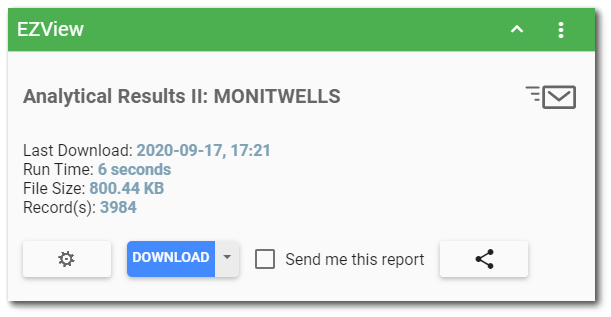
If EIA(s) are defined for the widget, an envelope icon is displayed in the upper right corner. Hover over the envelop icon to see how many EIAs are defined for the EZView widget. The left side of the widget displays the following:
Report Name – The name of the selected report.
Last Download – The date/time (end-user browser local time) that the report was last downloaded.
Run Time – The run time (i.e., elapsed time) indicates how long it took the report to run the last time it was downloaded (excludes download time).
File Size – The file size of the report output the last time it was downloaded.
Record(s) – If applicable, the number of records in the tabular output of the report the last time it was downloaded.
View/Edit Data
If the option to enable a link to the Report Parameter Editor is selected in the widget properties, the Edit ![]() icon will appear on the EZView widget to the left of the Download button. Clicking this icon opens the Report Parameter Editor in ad hoc mode. Depending on the user's permission for the selected report, the user can view/edit the report parameters, run the report with the selected parameters, and save the report or create a new report.
icon will appear on the EZView widget to the left of the Download button. Clicking this icon opens the Report Parameter Editor in ad hoc mode. Depending on the user's permission for the selected report, the user can view/edit the report parameters, run the report with the selected parameters, and save the report or create a new report.
Download or Send Data
To export the report output, click on the Download button to open a drop-down menu with download options.
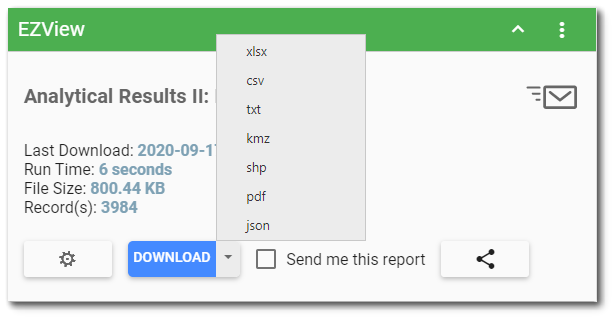
Report data can be sent directly to the user via email or to the Notice widget. Click the Send me this report option to enable this option and then select the report format. The report will then be sent directly to the user.
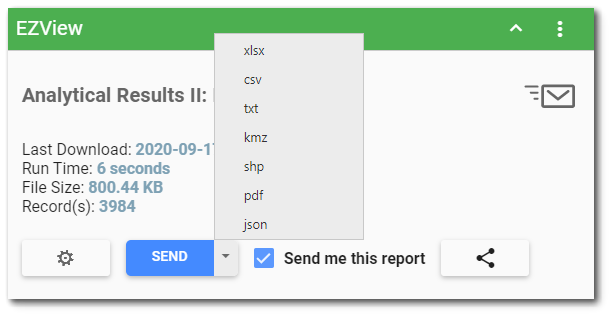
The following file types are available for export:
•.xlsx – Microsoft Excel workbook containing the tabular data.
•.csv – Comma-separated, double-quote delimited text file containing the tabular data.
•.txt – Tab-separated text file containing the tabular data.
•.kmz – Google Earth kmz file containing Placemarks for each location and a balloon pop-up with the tabular data for that location.
•.shp – A .zip file containing the Esri Shapefile (locations as features) and other related files (*.dbf, *.prj, etc).
•.pdf – A Portable Document Format (PDF) file displaying the tabular data.
•.json – JavaScript Object Notation (JSON) for grid data (e.g. IGridReport).
Note: The PDF output is produced by generating default Report Definition Language (RDL) to display the table of data and rendering that RDL as .pdf file. See the EQuIS Professional documentation for more information on customizing the default RDL used for displaying IGridReport data. |
|---|
RDL Reports
A published RDL Report will show two download options. See the EQuIS Professional documentation for more information on designing and publishing RDL reports:
•xlsx – The Microsoft Excel workbook produced by the published RDL as rendered by Microsoft's ReportViewer control.
•pdf – The PDF output produced by the published RDL as rendered by Microsoft's ReportViewer control.
"Class" Reports
A non-tabular report will only display the download option for the file type that it generates. For example, the "Google Earth: Locations" Report only generates *.kmz files, so only the .kmz option will be available.
Crosstab Reports
Crosstab reports with templates can be downloaded from the EZView widget like any other report. See the Creating Excel Templates article for for configuration details.
Share Report
A Share ![]() button is present on the EZView widget if the user has viewer permission and a report is selected. The Share button allows users to generate a link to the report for use in Esri ArcGIS Online or Microsoft Power BI. The link includes their own user token with a configurable expiration. The share button gives EQuIS users the ability to share key EQuIS information with others via a URL. The recipient does not need to have EQuIS installed or a license to view the information. For the URL token to be valid, the user creating the share URL must be assigned to the REST API role for an Enterprise site with a REST API License applied.
button is present on the EZView widget if the user has viewer permission and a report is selected. The Share button allows users to generate a link to the report for use in Esri ArcGIS Online or Microsoft Power BI. The link includes their own user token with a configurable expiration. The share button gives EQuIS users the ability to share key EQuIS information with others via a URL. The recipient does not need to have EQuIS installed or a license to view the information. For the URL token to be valid, the user creating the share URL must be assigned to the REST API role for an Enterprise site with a REST API License applied.
Note: The Share feature only works with user reports. It does not work with EIAs as a data source. |
|---|
Click the Share ![]() button to open the Share Report dialog window and generate the user token.
button to open the Share Report dialog window and generate the user token.
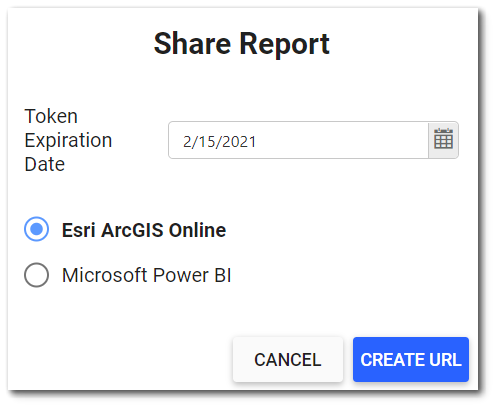
Use the calendar tool to select a Token Expiration Date. Select the other desired report share options. Click Create URL to open a dialog window displaying the token value. It is important to know that this is the only opportunity to view and copy the token value. Click the Copy button to automatically copy the token URL value to the clipboard and be available to share with others. The Close button will close the window.
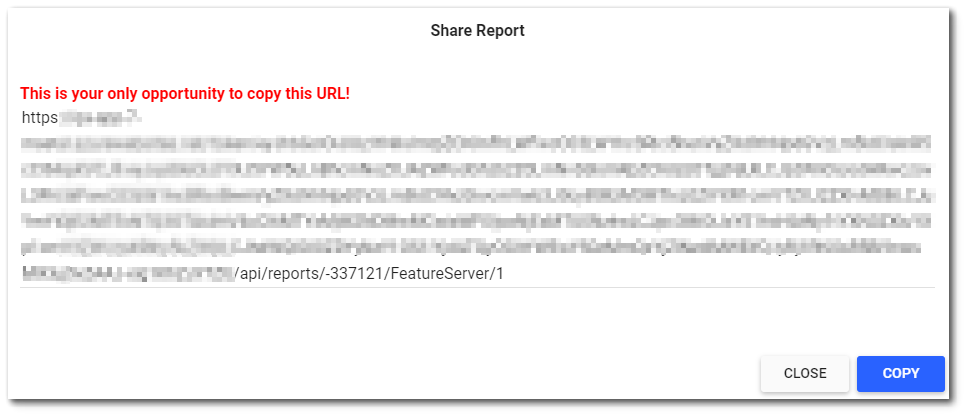
Warning: This is the only opportunity to copy the token URL value. After closing the Share Report window, the token value will not be accessible and new token will need to be created. |
Widget Properties
The editor for this widget allows the user to select a report, configure the report, and create EIAs. To add a report or edit other widget properties, open the Widget Editor by selecting the More Options ![]() icon in the upper right corner of the widget to display the drop-down menu and then select the Edit menu option.
icon in the upper right corner of the widget to display the drop-down menu and then select the Edit menu option.
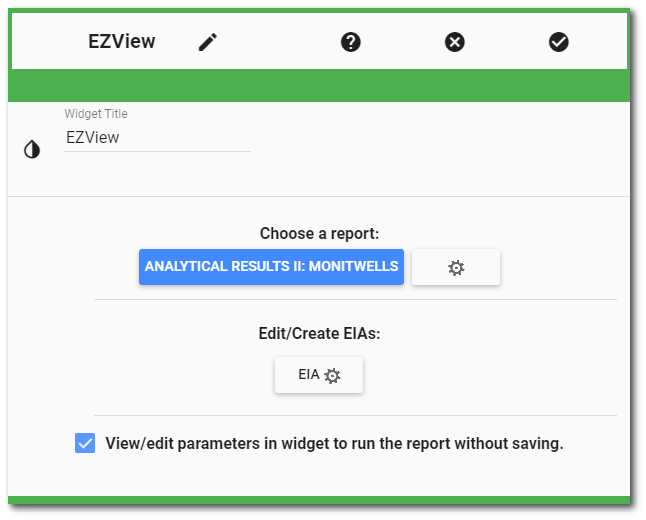
Widget Title – By default, the widget title is EZView. The title can be modified.
Widget Color – The color of the widget can be changed using the Widget Theme![]() icon to the left of the widget title.
icon to the left of the widget title.
Report Chooser – This control is used to select the report or EIA (as a data source) to be used with this instance of the EZView widget. The name of the currently selected report (if applicable) is displayed by default. To select a different report or EIA, click the Choose a Report button or name of the report. The Report Chooser will open and display available reports. Select the desired report or EIA.
Report Parameters – The report parameters (e.g., analytes, sample date range, etc.) can be edited by clicking on the Edit button ![]() to open the Report Parameter Editor for the selected report. A user with editor permission on the selected report may update the report.
to open the Report Parameter Editor for the selected report. A user with editor permission on the selected report may update the report.
Edit/Create EIAs – Select the EIA ![]() button to create or edit an EIA. See the EQuIS Information Agents chapter for a detailed discussion of EIAs.
button to create or edit an EIA. See the EQuIS Information Agents chapter for a detailed discussion of EIAs.
View/edit parameters in the widget to run the report without saving – Checking this option enables a link to the Report Parameter Editor. The ![]() icon will appear on the widget. Clicking this icon opens the Report Parameter Editor. Depending on the user's permission for the selected report, the user can view/edit the report parameters, run the report with the selected parameters, and save the report or create a new report.
icon will appear on the widget. Clicking this icon opens the Report Parameter Editor. Depending on the user's permission for the selected report, the user can view/edit the report parameters, run the report with the selected parameters, and save the report or create a new report.
Widget Object Editor – To set various appearance properties of the widget, select the Object Editor ![]() icon in the widget header to open the Widget Object Editor. See the Widget Editor article for more details.
icon in the widget header to open the Widget Object Editor. See the Widget Editor article for more details.
Help – The Help ![]() icon connects to the online documentation related to the specific widget.
icon connects to the online documentation related to the specific widget.
Copy Settings – Select the Copy Settings ![]() icon to to copy the settings from another widget of the same type. See the Copy Widget Settings article for more information.
icon to to copy the settings from another widget of the same type. See the Copy Widget Settings article for more information.
Cancel – Select the Close without Saving ![]() icon to exit the Widget Editor without saving changes.
icon to exit the Widget Editor without saving changes.
Save – Changes will be applied to the widget by clicking on the Save ![]() icon. The Widget Editor screen will close after the save operation is complete.
icon. The Widget Editor screen will close after the save operation is complete.